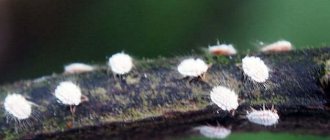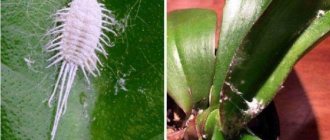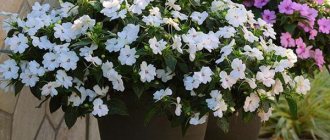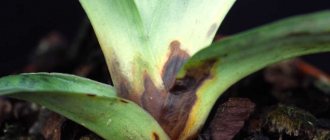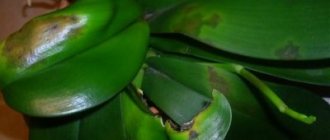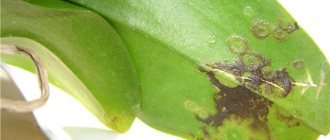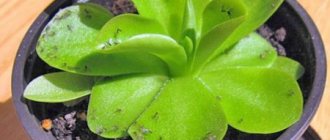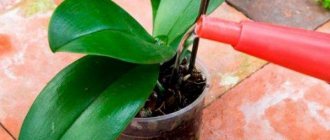Indoor plants decorate the interior when they are healthy and look good. The appearance of root rot leads to the fact that first the roots die, and then the flower loses its decorative effect and dies. Basically, this problem arises due to improper care, and you need to start fighting it immediately. Comprehensive measures will help to cope with root rot.
Description and photo
The stem of a diseased plant begins to darken, after which the infection spreads to the roots and the root system rots. This leads first to withering of the ground part, and then to complete death.
The causes of root rot are:
- waterlogged soil is the most favorite place for the development and reproduction of fungal infections;
- insufficient disinfection of contaminated soil before sowing seeds;
- poor disinfection of garden tools or growing containers in which rot was found;
- poor quality planting care.
Symptoms of root rot infection of plantings can be:
- slowdown in growth
- change in leaf color,
- the appearance of brown spots on the foliage,
- wilting and lodging of the ground part,
- drying of the foliage and the appearance of constrictions on it.
Fungal spores of root rot spread very easily through the air, with splashes of water during watering or rain, and are carried on clothing, hands and garden tools, and by insects. The disease can also spread to a plant through mechanical damage to the roots or stem. The pathogens persist for a long time in the soil and in the remains of infected specimens.
Classification of fungicides
According to the nature of the active substance
All fungicides are divided into 2 groups: chemical and biological.
Chemical
The active substance is a chemical compound. Among them, the most effective and efficient are:
- Bordeaux mixture;
- Copper sulfate;
- Abiga-pik, VS;
- zineb;
- potassium permanganate;
- soda ash.
Important! These products have been tested by experts, but they must be used with extreme caution according to the instructions. Otherwise, you can harm plants and humans.
Biological
The active substance is beneficial bacteria, leading to the death of pathogenic fungi.
Biofungicides are characterized by low toxicity, so they become more popular every year.
Biofungicides effectively fight fungi without harming green spaces, animals, fish, bees, or people. The best of them are:
- Alirin-B;
- Gamair P;
- Trichodermin;
- Albite;
- Agate;
- Fitosporin;
- Planzip and others.
By nature of distribution
Based on the nature of distribution in plant tissues, fungicides can be divided into the following:
- Contact or local. They remain outside, causing the death of the pathogen upon contact. The effectiveness of these products depends on many factors: weather conditions, duration of action, amount of fungicide, chemical resistance, etc.
- Systemic or intraplant. They are absorbed into the vascular system of plants, suppressing the development of the pathogen from the inside. The effectiveness of these products depends on the speed of penetration into tissue, and is practically independent of weather conditions.
Interesting! Some contact fungicides can penetrate the outer seed coats.
According to chemical properties
Fungicidal agents are divided into the following groups according to their chemical properties:
- Inorganic (compounds of sulfur, mercury, copper, nickel, potassium, iron, manganese and potassium);
- Organic. (do not contain heavy metals and decompose as a result of the action of living organisms).
Watch the video! FUNGICIDES - PREPARATIONS FOR DISEASES ON PLANTS
Organic fungicides have a number of advantages over inorganic ones:
- do not contain metals;
- they are easy to prepare by simply diluting them in water;
- can be combined with different pesticides.
Important! Inorganic fungicides are compatible with a small number of drugs.
On the other hand, organic preparations remain in the soil for only 3-14 days, after which they are destroyed.
According to the effect on the pathogen
Based on their effect on the pathogen, fungicides are divided into:
- Prophylactic or protective, which are used to prevent illness.
- Curative or eradicating, which kill fungi after the plant has been infected.
By purpose of use
Based on the purpose of use, fungicides are divided into treatment agents:
- Seed material.
- Ground.
- Plants during dormancy.
- Crops during the growing season.
- Storage of grains and vegetables.
Today there are many universal fungicides that are suitable for any treatment of both seeds and crops at different stages of the growing season.
Pathogens
There are many causative agents of root rot. Cereal crops are affected by the fungus Helminthosporosum sativum, Ophiobolus graminis, and Fusarium. In corn, the pathogens are fungi of the genus Fusarium, Diplodia, Pythium, Penicillin, and Rhizoctonia. In legumes, the disease is caused by fungi of the genus Aphanomyces, Thielaviopsis, Sclerutium, Rhizoctonia and Pythium. Tomatoes, cucumbers, potatoes and cabbage with onions are affected by the fungus Phytophthorum.
These fungal pathogens affect not only the above-listed crops, but also many others.
What drugs are there for effective control?
- Trichodermin is a fungicidal drug against many fungal and bacterial diseases. Very effective in combating root rot.
- Trichophyte is a biological preparation to combat root rot and gray mold.
- Fitolavin is a biological preparation for combating many putrefactive diseases during the seedling period.
- Fundazole is a very powerful remedy, but it is highly toxic to people and animals. Therefore, it is used only on ornamental plants, trees and shrubs.
- Topaz is a systemic remedy, but it gives the best results in prevention rather than in treatment of the disease.
- Previkur Energy is a new systemic medicine for root rot and other putrefactive diseases. Heals and stimulates the root system of herbs, trees and shrubs.
- Mikosan is a biological preparation intended for garden and indoor crops. Promotes the production of specific antibodies that form immunity to fungal and bacterial diseases.
- Copper sulfate is an antiseptic and fungicide at the same time. It is used for gardening and indoor plants in various doses depending on needs.
- Maxim is a systemic fungicide against root rot and many other diseases. Moderately toxic to humans and animals. It is also used to disinfect soil.
- Discor is a fungicidal remedy for many diseases of indoor and garden plants. Not dangerous for humans and animals. Has no smell.
- Glyokladin is a remedy for putrefactive diseases in garden beds.
- Gamair is a complex biological product for many diseases of indoor and garden crops.
- Vitaros is a means for treating seed material, bulbs and tubers against putrefactive diseases.
- Bordeaux mixture is one of the most highly effective drugs in the fight against many fungal and bacterial diseases.
All medications must be used strictly according to the instructions so as not to cause harm to yourself, animals and the environment.
How to apply fungicides to plants
Depending on the reasons for using a fungicide, select the appropriate dosage and follow certain rules.
For indoor plants
Seedlings are treated with fungicides after purchase to avoid mycosis and infection of other flowers. Preventive spraying is also carried out to increase plant immunity. Fungicide treatment helps prevent the spread of fungal spores.
For garden plants
Garden crops are sprayed with fungicides in early spring to prevent garden diseases. Trees are also treated under unfavorable climatic conditions and improper care. In the fall, the soil is disinfected before the winter dormancy of plants.
Folk remedies
- Chalk - 3 large spoons, copper sulfate - 1 small spoon, water - half a liter. Mix all ingredients until mushy and apply this paste to the upper part of the stem, root collar and upper part of the roots.
- Mix crushed chalk into dust with sifted wood ash in a ratio of 1 to 1. Treat the affected parts of the plant with this powder.
- Dilute iodine with water in a ratio of 1 to 4. The stem and upper part of the roots are treated with this solution.
- Prepare a slightly pinkish solution of potassium permanganate. Water it under the root and the ground around the stem of the affected specimen.
- 1 liter of milk, 10 liters of water, 30 drops of iodine, 20 g of finely grated laundry soap. Mix all ingredients until completely dissolved. Treat diseased crops with this solution every 10 days for a month.
Related article: Family of Acanthus plants: list, description, genera and species
Prevention: how to prevent disease
- In order to prevent plants from becoming infected with root rot, you need to choose seed material that is resistant to this disease.
- Before sowing seeds and seedlings, it is imperative to disinfect the soil by calcination or using various preparations. Seeds should also be disinfected.
- After contact with infected crops, garden tools must be treated with drugs or disinfected in any convenient way.
- After contact with an infected plant, be sure to wash your hands with soap and wipe with alcohol to prevent the spores from being transferred to healthy plantings.
- If the plant has died, it must be removed from the site along with the top layer of soil. Burn the remains and disinfect the soil.
- Excessive application of fertilizers to the soil can also lead to the proliferation of putrefactive bacteria and fungi. Therefore, it is necessary to comply with the norms for applying fertilizing.
- Avoid overmoistening the soil and stagnating moisture in the area. Treat crops and seedlings for prevention with pesticides and fungicides. Thin out the seedlings to allow more air to reach the roots.
- Carry out foliar feeding.
- Destroy planting residues and weeds after harvesting.
- If plants are grown in a greenhouse, then you need to ventilate it often and not create excessive humidity in the room.
By adhering to these simple rules, it is possible to avoid infection of vegetation with root rot. But if this happens and no action is taken, then all the crops may die. The harvest will be low and cannot be stored for long.
Plants affected by root rot are not suitable for food. But even if for some reason you eat a diseased specimen, nothing will happen other than a slight upset of the gastrointestinal tract.
How to protect crops from blackleg
To get healthy and strong seedlings, do not sow the seeds too early, because in a cold window with insufficient lighting, the shoots will quickly stretch, weaken and become easy prey for various diseases.
Please note that seedlings in peat tablets are practically not damaged by blackleg. The tablets are sterile and impregnated with fungicide. With this method of sowing, seedlings are not picked, but transplanted into pots along with a tablet.
Seedlings damaged by blackleg
The soil prepared in the garden for sowing flowers and vegetables for seedlings must be thoroughly disinfected. A convenient way is to place the soil in a colander and a large saucepan filled 1/4 with water. Place the pan on the fire and boil for 10–15 minutes. After steaming, it is advisable to let the soil “rest” for about two weeks - during this time, beneficial soil microorganisms will “wake up” in it. If you don’t have time for this, you can spill it with a solution of any EM preparation (“Baikal”, “Shine”, “Vozrozhdenie”).
There is no need to thoroughly steam purchased soil for seedlings: the high-moor peat from which it is made is sterile. True, slowly developing seedlings (for example, salvias, begonias, lobelias) can be damaged by the larvae of fungus gnats, which are often found in bags with peat substrates, so it is still useful to hold the purchased soil over steam for at least five minutes to destroy the insects.
Root rot
Tomato root rot
Root rot is a common plant disease caused by various types of fungi and sometimes bacteria. It affects seedlings and adult plants.
Root rot on seedlings is called “blackleg”. In seedlings, the tip of the main root dies. The root collar and adventitious roots turn black, later the tissues on them become thinner, and numerous constrictions form. A white or pink coating forms at the sites of infection.
Adult plants stop growing, their leaves turn yellow and wither, the shoots dry out, and the ovaries crumble. If you remove a diseased plant from the ground, the darkened, plaque-covered roots fall off the stem when touched. Plants often die completely from root rot.
Description of the disease
Pathogens of root rot are widespread and develop in all regions. In our opinion, annual herbaceous plants suffer more, since they have weaker immunity. High humidity, which is observed during overflows and frequent precipitation, contributes to the infection and spread of the disease. Under such conditions, the plant's roots do not receive enough oxygen and are unable to resist fungi.
Pathogens
The disease is caused by different types of fungi that attack the roots (Armillaria mellea, Rosellinia necatrix, etc.). They develop in various types of soil, which contributes to the wide spread of the disease. Root rot affects many types of crops and wild plants: cereals, corn, tomatoes, onions, cabbage, cucumbers, flowers, etc.
Fungi that provoke the development of rot are active in a wide temperature range - 2-40 ° C. But the optimal values at which mushrooms multiply intensively are 18-28 °C. The impetus for the active growth of pathogens is the following factors:
- unfavorable weather conditions (rainy);
- heavy soils;
- violations in plant care.
Symptoms
The main difficulty in the fight against root rot is the difficulty of diagnosing the disease in the early stages of development. Once the disease is identified, it is almost impossible to cure it. Symptoms vary among different crops, but there is one thing in common: the root system suffers from the disease. The root collar of a sick plant rots; if you dig up the crop, you can see the affected areas of the roots.
Symptoms of root rot in popular vegetable crops
| Tomatoes | General wilting even with watering, necrosis of lower leaves |
| cucumbers | The appearance of spots on the leaves, yellowing of the leaves, death of the ovary and browning of the fruits |
| Onion | The appearance of streaks or brown spots on plants at soil level, their growth and the formation of constrictions |
On a note!
Zoospores of pathogens are very viable: they are preserved on plant debris from which they enter the soil, on seeds
Types of root rot
The type of disease depends on the pathogen, which, in turn, affects the choice of treatment regimen. Symptoms, course and consequences are very similar between species. The difference is what crops they attack.
Ophiopathic root rot
The pathogen develops intensively in soils in which there is a deficiency of organic matter. It affects plants at the earliest stages: seeds show low germination, and the emerging seedlings are very weak. The stems turn black, become thinner and break when exposed to wind or watering. This type of disease is often called “black leg”.
Cercosporella
Foci of this type of disease are observed during warm and mild winters with frequent thaws. It is during these periods that the pathogen actively grows and multiplies, infecting plants. Mostly perennial crops suffer from fungal spores.
Helminthosporium
The most common type. It is characterized by classic manifestations and course of the disease. The wide distribution of the pathogen is due to its “indiscriminateness”: it affects both cultivated and weed plants. If the latter are not removed from the site, they “preserve” spores, which then infect the planted crops.
Fusarium
A species that poses a threat to the grain production industry in agriculture. First, spots appear on the lower parts of cereal plants, and then the crops lie down. The danger is that the spores spread not only to neighboring plants, but are also carried over large areas by the wind. As a result, the entire field becomes infected, and the yield is reduced by 20% or more.
On a note!
To avoid having to frequently resort to fungicides to save the crop, it is necessary to adhere to the sowing dates and planting depth recommended for the region.
Rhizoctoniosis
Common on cereals and potatoes. The type of disease has an alternative name - “black scab”. Spores spread intensively in heavy bunches with a neutral or slightly acidic reaction. Although, according to experimental data, acidity does not have a significant effect on distribution.
Causes
Infection occurs during prolonged waterlogging of the soil. Access of oxygen to the roots becomes difficult, the plant weakens, and its roots die. The development of the disease is facilitated by watering with cold water, planting in unheated soil, and sharp fluctuations in air and soil temperatures.
The disease can spread to healthy plants even when normal watering is restored. In this case, the cause of the infection is pathogenic fungi in the soil. They do not manifest themselves for a long time, and even a single waterlogging of the soil can be the impetus for reproduction. In rare cases, the source of infection is seeds.
General information
All flower diseases require immediate response due to the fact that limited indoor space contributes to the rapid development and spread of the disease even to healthy home crops. The sources of diseases are bacteria, fungi, viruses and pests. You can remove the latter yourself and make sure that harmful insects disappear from the apartment. But with other sources of disease, it is necessary to carry out a set of measures aimed at eliminating the cause of the disease and subsequently restoring the healthy state of the home flower.
Root rot of various plants
Tomatov
On seedlings, root rot appears as a “black leg”, on adult plants as Fusarium and Verticillium wilt. Chlorotic spots form on the leaves, which darken over time and crack in the center. The bush as a whole withers, some of the leaves become bright yellow. Black stripes appear on the petioles and stems. The fruits are covered with small dark spots with a white border.
In addition to tomatoes, root rot affects other nightshade crops - peppers and eggplants .
Ogurtsov
Characteristic symptoms of the disease are browning and loosening of the root collar and roots. On the aboveground part, the lower leaves turn yellow, and those that grow higher fade. The ovaries dry out and the fruits do not have time to develop.
Other related plants are also susceptible to the disease - zucchini, pumpkin, melon, watermelon .
Fruit crops
Apple, pear, grape, apricot, and cherry trees suffer from root rot . Affected roots become loose, bark and wood turn black. Plants stop growing and produce little root growth. The leaves grow small, they turn yellow and dry out. Due to the disease, the fruits do not have time to set.
Houseplants
Overmoistening affects Saintpaulias, cyclamens, gloxinias, and citrus fruits . The roots turn brown and rot, and the root part of the stem becomes thinner. In adult plants the leaves turn yellow, in young plants the foliage does not have time to change color, the roots quickly die and the plant dies.
Means of struggle
Chemical and biological drugs
Previkur Energy
The fungicide is used to treat seeds, water the soil and spray plants. For root rot, prepare a working solution from 3 ml of the drug and 2 liters of water. Use 4-5 times per season, the last time no later than 3 weeks before harvest.
Related article: List of plants starting with the letter G: indoor, garden and vegetable gardens
Fundazol
Contact-systemic fungicide for treating planting material and spraying vegetative plants. Flower bulbs are immersed for 3–4 hours in a solution prepared from 10 g of the drug and 2 liters of water, potato tubers and other vegetables are sprayed with a solution of 10 g of fungicide and 0.5 liters of water. For root rot, the leaves and soil are treated 2 times with a 0.1% working solution.
Maxim M
The contents of the ampoule are added to 1 liter of water. The resulting solution is used during the day for watering or spraying.
Glyocladin
The biological product is produced in the form of tablets. Use without prior dissolution in water. Tablets (1 piece per 300 ml of soil) are added to the ground when picking seedlings or transplanting plants to a permanent place.
Alirin-B
For irrigation, prepare a solution - dissolve 2 tablets in 10 liters of water. The drug is used 3 times with a break of 7 days.
Trichodermin
An effective biological product for treating plants at the initial stage of the disease. Available in powder or suspension form.
The concentrate is immediately poured with water, and a working solution is first prepared from the powder - 1 g per 200 ml of water, left for 2 hours in a dark and warm place for maturation. For watering and spraying, 5 g of concentrate is diluted in 1 liter of water.
Traditional methods
- The soil is disinfected with a solution of potassium permanganate and the plants are sprayed. For foliar treatment, use a 3% solution (3 g of the drug per 10 liters of water), the seedlings are watered with a 0.2% solution.
- Damaged areas on the stems in the root zone are sprinkled with charcoal or ash.
- In addition to the use of fungicides, at the first signs of infection, plants are given “first aid” by removing infected parts: stems or roots. The diseased specimen is dug up and carefully examined. If all the roots are wet and darkened, then the plant has no chance to survive.
- If most of the roots are elastic and healthy, then they are washed well with water. Then rotten roots, leaves, and shoots are cut off. The tops of healthy stems are also removed in order to balance the above-ground part with the root system that has lost volume. The plant is transplanted into new soil and placed in a shaded place. Water with caution only when it has taken root.
Oksikhom
Another copper-containing fungicide with wide application. In addition to copper hydroxide, the manufacturers included a new agrochemical, oxadixil. Due to this combination, the drug received not only a contact, but also a systemic effect. By acting on pathogens, it simultaneously destroys them and suppresses cell division, which stops the development of spores. The pesticide is a fast-acting substance (the effect on the infection begins in the first 2-3 hours), and it has a long-term preventive effect.
Drug Oxychom
Oxychom is produced in the form of a wettable powder. For spraying indoor plants, a solution of 2 grams of product per 1 liter of water is usually used; to treat red burn of bulbous plants (amaryllis, hippeastrum) you will need 2 times more of the product. Treatment is carried out up to 3 times every 10 days. Since copper hydroxide tends to settle, the finished liquid must be stirred periodically during the procedure.
Prevention
The main preventive measures are maintaining optimal soil moisture and temperature.
For seedlings, loose soil that is well permeable to air and moisture is used - a mixture of turf soil and humus with the addition of river sand or well-decomposed peat.
The seedlings are watered with warm water at a temperature of at least 20°C as the top layer of soil dries.
At the first signs, when only a few specimens are sick, they are immediately removed from the garden so that the disease does not become widespread. In such cases, a small layer of top soil is removed and peat, dry sand or sawdust is added.
Indoor plants are planted in pots and containers with drainage holes.
When growing vegetables and annual ornamental crops, crop rotation is observed to avoid the accumulation of fungi in the soil that cause infection.
Root rot is caused by various pathogenic fungi, but in all cases it is important not to miss time and begin treatment so as not to lose all the plants.
You will learn more about the fight against root rot in the video.
How to breed
The optimal dosage is calculated depending on the drug, type of treatment and plant crop. The working solution is prepared in a clean spray bottle by mixing the fungicide with water.
The product is thoroughly mixed and applied. The main thing is to follow these rules. The procedure is carried out when:
- The air temperature is not lower than 0 degrees.
- In dry, windless weather.
Advice! For emergency use, it is better to use systemic fungicides.
Remedies for root rot on indoor flowers
Indoor plants decorate the interior when they are healthy and look good. The appearance of root rot leads to the fact that first the roots die, and then the flower loses its decorative effect and dies. Basically, this problem arises due to improper care, and you need to start fighting it immediately. Comprehensive measures will help to cope with root rot.
Plant condition assessment table
There is a table that can be used to score each plant based on its appearance.
With a score of 1 point, you can not take active actions. Manifestations that correspond to this rating do not affect the yield and will not cause losses to the economy of your farm. With a rating of 4 points, the plant can be said to die.
And at what point, at what stage should you start solving the problem of root rot? We can say that actions at any stage are practically meaningless.
Cercosporellosis is controlled by fungicides at the stage of symptom onset, ophiobolosis can be protected from by prophylaxis, and other types of rot cannot be affected directly in the field.
If root rot has appeared in your field, it is most likely the result of erroneous actions last season.
Description and causes of the disease
The causative agents of root rot are pathological fungi from the oomycete genus. Most often these are Phytophthora, Pythium, Phytophthora.
Microorganisms may initially be present in the soil without manifesting themselves in any way, and begin to actively develop under conditions that are optimal for them. Particularly dangerous is a type of root rot called late blight, which often attacks young plants, causing them to die in a matter of days. For example, this often happens when seedlings are grown incorrectly.
The main reason that provokes the appearance of root rot is a violation of agricultural technology, namely, waterlogging of the soil. With excessively abundant watering, the soil does not have time to dry out, the earthen ball becomes excessively compacted, and oxygen ceases to flow to the roots.
This leads to the creation of a stable aerobic environment in the root areas. Stagnation of moisture in a pot often occurs at low temperatures; in this case, the water simply does not have time to evaporate between waterings.
The source of infection can be not only contaminated soil, but also used flower pots and contaminated tools.
Fungicide for root rot in ophiobolosis
Externally, damage to the root system by opheobolosis cannot be noticed. It occurs in a very short period, and the fungus remains in the soil for 10-15 years.
Ophiodisease is not transmitted by seeds. In anaerobic conditions of high humidity, about once every 4-5 years it gives an explosion in development. As a rule, this manifests itself in the south of Russia and in the Central regions, and much less often in other regions.
The occurrence of ophiobolosis can be predicted if there was at least 40 mm of precipitation in May. Then the disease begins to appear not as an isolated case, but as a lesion of most of the field.
What drugs can block it? Fungicides from “Makhteshim” or preventive treatments with strobilurins during the period from the beginning of booting to the end of tillering are suitable. The amount of working fluid should be sufficient to spill the product to the root collar.
Symptoms of root rot
The disease often affects vegetable and flower crops grown in the garden, and even grain crops (wheat, barley, oats, rye). She doesn’t shy away from indoor flowers either.
At home, root rot is often found in plants for which excessive watering is detrimental:
Unlike blossom end rot, root damage cannot be detected immediately. The insidiousness of the disease lies in the fact that at first the pathological process takes place underground and remains invisible to the owner of the flowers. At the height of the disease, due to disruption of the roots, symptoms also appear on the vegetative part. The leaves begin to turn yellow and wither, and the plant looks lifeless. Sometimes the grower mistakes these signs for a lack of moisture and floods the flower even more.
Related article: Shade-tolerant indoor plants: names and photos, types
Root rot can only be accurately recognized after removing the plant from the pot. You need to carefully examine the roots. If they turn out to be soft and black, then the suspicions are confirmed.
If you touch diseased roots, they will immediately fall off. The disease especially quickly affects newly rooted cuttings and young seedlings. In this case, signs in the form of yellowing and wilting of leaves do not even have time to appear. In a matter of days, the roots and lower part of the stem rot completely.
Treatment with folk remedies
You can get rid of root rot on indoor plants using folk remedies only at the initial stage of the infection. The lower part of the stem and the surface layer of soil are watered with the prepared solutions, and the roots are treated. For this purpose you can use:
- Potassium permanganate. It is necessary to prepare a pale pink solution of potassium permanganate and water the plant at the base of the stem and around it. This product should not be used in strong concentration, otherwise the roots may burn.
- Iodine with milk. For irrigation, prepare a solution of 1 liter of milk, 30 drops of iodine, 30 g of crushed plain soap per 10 liters of water. To obtain the effect, you will need 3 treatments with an interval of 10 days. A necessary condition is the normalization of the watering regime for the diseased plant.
- Paste based on chalk and copper sulfate. You need to mix 3 tbsp. spoons of crushed chalk, 1 teaspoon of copper sulfate and 0.5 liters of water. After mixing, a liquid with a creamy consistency is obtained, which should be used to lubricate the lower part of the stem, root collar and affected roots. After treatment, the roots are slightly dried and the plant is planted in fresh soil.
- Wood ash and chalk. Both components are mixed in equal proportions, after which the roots of the diseased plant, extracted from the ground, are dusted with powder. At the end of the treatment, the plant is replanted.
If root rot is detected, it is better not to be lazy and replace the soil in the pot with disinfected soil. Fresh soil should be shed in advance with a solution of potassium permanganate or boiling water. This should be done a week before transplanting, so that in the remaining time the soil will be populated by beneficial microorganisms. In the future, it will be necessary to water the flowers less often and with less water.
Fitosporin-M
The systemic fungicide Fitosporin-M is a preparation of biological origin. The waste products of Bacillus subtilis, which make up the active ingredient of the pesticide, suppress the proliferation of pathogens that cause diseases. The breadth of use of the biofungicide is noted by both gardeners and home gardening enthusiasts. At the same time, it has low toxicity for humans and animals and is absolutely non-phytotoxic. It is possible to spray plants at any time during the growing season, as well as watering to treat the soil, and soaking the seed material and root system of seedlings before planting.
Fitosporin
Three forms of the drug are available, differing in the number of bacteria per unit of substance and solubility in water.
- The powder has the largest number of spores and living cells, but it does not dissolve well and requires pre-soaking 1-2 hours before treatment. For prevention, spraying is carried out with a solution of 0.5 teaspoon (1.5 g) per 2 liters of water, for treatment: the same amount of the drug, but per 1 liter of water. For soaking and watering, dilute 2 grams in 1 liter of water.
- The biofungicide is easily diluted in paste form, but it has the lowest bacterial titer. To water the soil, use 15 drops of the substance per 1 liter of water, and 10 for spraying.
- The average between the two previous forms is an aqueous suspension, which also has a gentler effect on plants. The solution for all types of its use will be the same: 10 drops of fungicide per 1 glass of water.
Use of drugs
A guaranteed result can be obtained by treating a fungal infection with fungicides.
If the flower begins to wither when the soil in the pot is excessively wet, it must be urgently removed from the container and action taken. The roots are washed with water, all affected areas are cut off and soaked in a fungicidal solution.
Effective preparations for root rot:
- “Alirin-B” – 1 tablet per 5 liters of water;
- “Vitaros” – 2 ml per 1 liter of water;
- “Oxychom” – 10 g per 5 liters of water;
- “Ordan” – 5 g per 1 liter of water;
- “Gamair” – 2 tablets per 1 liter of water;
- “Hom” – 20 g per 5 liters of water;
- “Previkur Energy” – 3 ml per 2 liters of water;
- “Baktofit” – 10 ml per 5 liters of water.
The solution is prepared immediately before treatment. The roots should remain in it for 15–20 minutes. Features of use are indicated in the instructions for the drug.
Disease prevention
Since root rot is almost impossible to get rid of, its development should be prevented. In addition, this approach is economically beneficial: you can save a significant amount of money on treatment.
Growing rot-resistant varieties
The growing process begins with the selection of varieties. The catalog of the latter is annually updated with new developments, which have improved many characteristics, including resistance to pathogenic organisms. Although the price of such seed or planting material is higher, the varietal representatives have strong immunity, which makes it possible to avoid the development of root rot even at the seedling or seedling stage.
You cannot obtain seeds from hybrid plants yourself: they lose the qualities of the parent specimen. When growing vegetables, if there are extensive outbreaks of disease in the area, you should not save money by using your own seed. It is better to annually purchase seeds of hybrids bred specifically for such regions.
Fertilizer application
Plants need balanced nutrition at all stages of growth. Fertile soil provides strong immunity that can resist root rot pathogens. Feeding begins at the seedling stage, since during this period the crops are most vulnerable.
But although ophiopathic rot affects plants in soil poor in organic matter. The latter is introduced carefully, since it is often a source of harmful microorganisms. Among organic fertilizers, preference is given to wood ash. It not only enriches the soil with nutrients, but also has a disinfecting effect.
Soil disinfection
Often the cause of plant rot is contaminated soil. Before sowing seeds for seedlings, it is disinfected using one of the convenient methods:
- Heat in the oven for 20 minutes at 200 °C.
- Steam in a steam bath for about 30 minutes.
- Place in the microwave for 10 minutes at maximum power.
The soil in the garden beds is also disinfected. Before planting plants or sowing seeds directly into the holes, pour boiling water over it. If plants suffering from the disease were previously grown on the site, the soil is disinfected with a fungicide solution.
Seed treatment
When purchasing treated seeds, this preventive measure is skipped. Any manipulations can, on the contrary, damage the protective shell. Self-harvested or unprocessed seeds must be prepared. First of all, calibration is carried out by removing substandard specimens that will not sprout, which can be misleading. Sequencing:
- Prepare a saline solution - 3-5%.
- Seeds are placed in it and mixed vigorously.
- After 5 minutes, they are drained together with the non-drowning specimens.
- The rest are washed and dried in the shade.
Then they begin disinfection to destroy the pathogen, if any. Use a 0.5-1% solution of potassium permanganate, baking soda (5 g per 1 liter of water) - with exposure for 20 minutes. In our opinion, a 10% solution of hydrogen peroxide, preheated to 40°C, is effective. It is enough to soak the seeds in it for 7-8 minutes.
Compliance with crop rotation and irrigation regime
Since root rot develops in conditions of high humidity, moisture should not be allowed to stagnate in the root system of plants. This is achieved by complying with planting/sowing requirements (to soil, location), as well as the irrigation regime recommended for a specific crop. In case of frequent rainfall, regular loosening is carried out to facilitate oxygen access to the roots.
Crop rotation must not be disrupted, since it is designed taking into account the accumulation of specialized pests and diseases in the soil. Growing a crop in the same place for several years leads to a significant decrease in yield even when planting healthy planting material due to the development of diseases due to intensive reproduction of the pathogen.
Root rot is a dangerous disease that is difficult to treat. In our opinion, it is important to follow the agricultural technology of growing crops, then it will be possible to avoid the development of pathogens and preserve the harvest and decorativeness of plants.
Preventive measures
Prevention of fungal infection on the roots begins even before planting the flower in a pot. In the future, each plant needs suitable care.
- When propagated by cuttings, the stem is immersed in a fungicide solution for 5–10 minutes and only then planted.
- If seeds are used, they must be treated before sowing. This can be done using a pale solution of potassium permanganate or one of the fungicides.
- Flower pots should be washed with soap and rinsed with boiling water before use.
- The soil also needs sterilization. There is no need to cultivate the purchased land; the producer has already done this.
- The tool used for planting flowers must be clean; before carrying out work, it is additionally wiped with alcohol, vodka or a solution of Chlorhexidine.
- If you had to handle a diseased flower, you must wash your hands thoroughly before touching other plants.
- In the room, if possible, you need to maintain a humidity level of 40–60% and a temperature of 18°C, and also ventilate it regularly.
- Indoor plants should be watered with a moderate amount of water and not too often, taking into account the individual needs of each flower. Most plants need the top layer of soil to dry out between waterings.
- Stagnant moisture is especially harmful for succulents and epiphytic vegetation (for example, orchids).
- Fertilizer should be applied in doses, since excess minerals can provoke the growth of pathogenic microflora.
So, in order to avoid fungal diseases, one of which is root rot, you need to properly care for your flowers, starting from the planting stage. It is necessary to take into account the individual needs of the plant for moisture and adjust the watering schedule when external conditions change. The first signs of the disease should be a signal for the immediate start of treatment.
Sources:
https://3vedra.com/bolezni-rastenij/kornevaya-gnil.html https://sad6sotok.ru/%D0%BA%D0%BE%D1%80%D0%BD%D0%B5%D0%B2% D0%B0%D1%8F-%D0%B3%D0%BD%D0%B8%D0%BB%D1%8C.html https://goodgrunt.ru/bolezni/kornevaya-gnil.html
Agat-25K
Biofungicide "Agat-25K" can be called a drug with multisystem action. It is created on the basis of waste products of bacteria Pseudomonas aureofaciens H16; in addition, the manufacturer added bioactive substances, micro- and macroelements, and active fractions of pine extract to the composition. Thanks to this complex of components, plant immunity is increased, thereby developing resistance to infection, as well as activating the growth of crops and increasing their resistance to adverse factors. The fungicide is safe for both humans and animals, as well as the environment, and has a beneficial effect on the root zone, acting as a fertilizer. The drug combines well with other agrochemicals, and when used together with herbicides, it reduces their negative effects.
Agat-25K
In the retail chain, the product is presented in a dark paste form, placed in a syringe with a measuring scale. The solution is prepared in two stages: first, the required amount of biofungicide is diluted in a small amount of water, then the resulting liquid is added to the filled sprinkler. To treat indoor plants, only 3 grams of the drug are required per 10 liters of water. Spraying is carried out 2 times a month.
The table below shows the most common fungal diseases, the houseplants they affect, and the most popular fungicides.
| Disease | Plants | Fungicides |
| Alternaria and dry spotting | Hybrid petunia; Pelargonium; Gerbera; Zinnia; Orchids; Dracaena | Abiga-pik, Oksikhom, Vitaros, Agat-25, Baktofit |
| Downy mildew (Peronosporosis) | Bulbous plants; Roses; Wisteria; Begonias; Palms and other monocots; Saintpaulias and plants with densely pubescent leaves | Abiga-pik, Oksihom |
| Powdery mildew | Laurel; Saintpaulia; Gloxinia; Roses; Gerberas; Kalanchoe | Vectra, Oksikhom, Vitaros. Prevention: Fitosporin-M |
| Septoria | Hydrangeas; Anthurium; Rose; Rhododendron; Azalea; Carmona parvifolia | Abiga-pik, Diskor, Vitaros |
| Gray rot | Decorative ferns; Asparagus; Homemade chrysanthemums; Oriental hyacinth; Myrtle tree; Monstera; Ficus; Flower Male happiness; Spathiphyllum; Gloxinia; Violets; Cyclamen; Begonia | Fitosporin-M |
| Leaf rust | Gerberas; Fuchsia; Carnation; Cyclamen; Pelargonium; Rose; Geranium; Chrysanthemum; Asparagus; Citrus bushes; Palm trees of different types | Abiga-pik, Vectra, Oksihom. Doesn't help: Fitosporin-M Baktofit |
| Phyllosticosis (brown spot) | Hibiscus; Roses; Orchids; Begonias; Dracaenas | Vectra, Abiga-pik, Discor, Vitaros |
| Root rot | Orchids; Saintpaulia; cacti | Baktofit, Oxychom, Vitaros |
| Spotting | Any indoor plants | Prevention: Fitosporin-M, Baktofit. Treatment: Abiga-pik, Oksikhom, Vectra, Vitaros |
| Black spot | Palm trees; Orchids; Camellias; Anthuriums | Abiga-pik, Vectra, Oksihom, Vitaros |
| Verticillium wilt | Chrysanthemums; Hibiscus | Vectra, Agat-25K |
| Fusarium (fusarium wilt) | Orchids; Begonias; Fuchsia; Balsam; Azalea; Pelargonium; Chrysanthemum; Cyclamen | Vectra, Vitaros |

